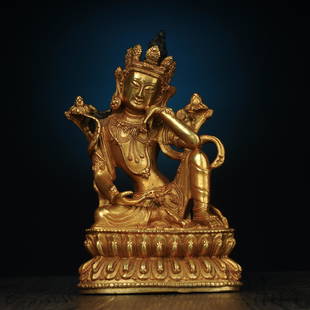
Important Hellenistic Bronze Statue of Bucephalus
Similar Sale History
View More Items in ArtRelated Art
More Items in Art
View More






Item Details
Description
Greece, Hellenistic, ca. 3rd century BCE. A finely cast bronze sculpture of Bucephalus, the mighty steed belonging to Alexander the Great, bravely tamed by the young prince before a skeptical audience, to prove his might (see extended description below for this entertaining legend). The powerful horse, reportedly much larger than most Macedonian horses of the time, is depicted in motion; note the dynamic positioning of the legs (front leg rearing up). Only Alexander could ride the wild Bucephalus and the two were inseparable, working together in every battle, until Bucephalus was kidnapped following his final defeat of Darius, while Alexander was on an excursion. With this news Alexander boldly declared that he would destroy the countryside - fell every tree and kill every inhabitant, a threat that resulted in the return of his horse and the guilty party begging forgiveness. Size: 7.75" W x 7.125" H (19.7 cm x 18.1 cm); 7.625" H (19.4 cm) on included custom stand.
Bucephalus was Alexander the Great's valiant stallion, regarded as the most famous horse throughout history. The story of their pairing is quite marvelous. Bucephalus was first brought to Macedonia and presented to Alexander's father, King Phillip II, in 346 BCE by Philoneicus of Thessaly. The magnificent horse was much taller than the typical Macedonian bronco; however, he appeared to be way too unruly and wild. So Phillip ordered that he be taken away. Young Alexander was watching from the audience with his mother Olympias. He stood up, called the attendants weak, and according to Plutarch's biography, the handsome prince said, "What an excellent horse do they lose for want of address and boldness to manage him." Phillip responded, "Do you reproach those who are older than yourself, as if you were better able to manage him than they?" Alexander then declared that he would pay for the horse if he could not tame the noble steed. Alexander, ignoring the uproarious laughter of the crowd, approached the horse calmly, for he had recognized something that no one else apparently had; the horse was simply afraid of his own shadow. So Alexander wisely turned the horse toward the sun, so that his shadow as behind him, took the reigns, mounted him, and rode off. When Alexander returned to the arena and dismounted, Phillip said, according to Plutarch, "O my son look thee out a kingdom equal to and worthy of thyself, for Macedonia is too little for thee." In short, this seemingly miraculous taming of the wild Bucephalus signified a turning point and demonstrated that Alexander would be the mighty conqueror of most of the known world of his day.
Provenance: private East Coast, USA collection
All items legal to buy/sell under U.S. Statute covering cultural patrimony Code 2600, CHAPTER 14, and are guaranteed to be as described or your money back.
A Certificate of Authenticity will accompany all winning bids.
We ship worldwide to most countries and handle all shipping in-house for your convenience.
#127648
Bucephalus was Alexander the Great's valiant stallion, regarded as the most famous horse throughout history. The story of their pairing is quite marvelous. Bucephalus was first brought to Macedonia and presented to Alexander's father, King Phillip II, in 346 BCE by Philoneicus of Thessaly. The magnificent horse was much taller than the typical Macedonian bronco; however, he appeared to be way too unruly and wild. So Phillip ordered that he be taken away. Young Alexander was watching from the audience with his mother Olympias. He stood up, called the attendants weak, and according to Plutarch's biography, the handsome prince said, "What an excellent horse do they lose for want of address and boldness to manage him." Phillip responded, "Do you reproach those who are older than yourself, as if you were better able to manage him than they?" Alexander then declared that he would pay for the horse if he could not tame the noble steed. Alexander, ignoring the uproarious laughter of the crowd, approached the horse calmly, for he had recognized something that no one else apparently had; the horse was simply afraid of his own shadow. So Alexander wisely turned the horse toward the sun, so that his shadow as behind him, took the reigns, mounted him, and rode off. When Alexander returned to the arena and dismounted, Phillip said, according to Plutarch, "O my son look thee out a kingdom equal to and worthy of thyself, for Macedonia is too little for thee." In short, this seemingly miraculous taming of the wild Bucephalus signified a turning point and demonstrated that Alexander would be the mighty conqueror of most of the known world of his day.
Provenance: private East Coast, USA collection
All items legal to buy/sell under U.S. Statute covering cultural patrimony Code 2600, CHAPTER 14, and are guaranteed to be as described or your money back.
A Certificate of Authenticity will accompany all winning bids.
We ship worldwide to most countries and handle all shipping in-house for your convenience.
#127648
Condition
Losses to limbs as shown. Cast with opening in the sway of the back as well as the hind leg as shown. There is a rounded, green finished wood insert to connect the piece to the stand. Old loss, perhaps a casting flaw, to the mane.
Buyer's Premium
- 24.5%
Important Hellenistic Bronze Statue of Bucephalus
Estimate $25,000 - $35,000
7 bidders are watching this item.
Get approved to bid.
Shipping & Pickup Options
Item located in Louisville, CO, usSee Policy for Shipping
Payment

Related Searches
TOP


































































